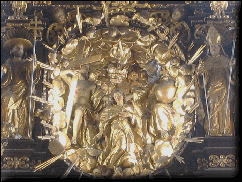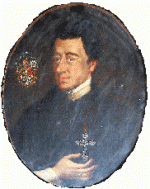The Thirty Years’ War
 The number of monks in Vyšší Brod itself was never as high as in some big abbeys, where there were hundreds of monks. The chancel had stalls for 42 monks. When the General Abbot Nikolaus Boucherat from Citeaux made a visit to Vyšší Brod, the community had only 14 monks with solemn vows, 1 novice and 3 lay brothers; 6 other monks were entrusted with service outside the monastery. Yet, this was before the Thirty Years’ War. The war, however distant its major events, brought about hard times for the monastery, its occupants and subjects as it was a time, according to chroniclers’ records, of endless military requisitioning, billeting, robbery and plunder. In 1636 there were 77 deserted farmsteads in the monastery domain and their number was increasing steadily.
The number of monks in Vyšší Brod itself was never as high as in some big abbeys, where there were hundreds of monks. The chancel had stalls for 42 monks. When the General Abbot Nikolaus Boucherat from Citeaux made a visit to Vyšší Brod, the community had only 14 monks with solemn vows, 1 novice and 3 lay brothers; 6 other monks were entrusted with service outside the monastery. Yet, this was before the Thirty Years’ War. The war, however distant its major events, brought about hard times for the monastery, its occupants and subjects as it was a time, according to chroniclers’ records, of endless military requisitioning, billeting, robbery and plunder. In 1636 there were 77 deserted farmsteads in the monastery domain and their number was increasing steadily.  The monastery was heavily in debt. In 1648, towards the end of the war, Swedish troops made it as far as South Bohemia and Vyšší Brod. The community was temporarily transferred to other monasteries, not only due to the dangers of war but also because the monastery was not always able to support the whole group materially. Yet in the meantime, there were also quiet periods in which the monastery was able to recover a little from war damage. This was so especially under the able Abbot Georg III Wendschuh, Knight of Zdir (1641 – 1668) from Lusatia, who was one of the most remarkable abbots of Vyšší Brod. He was a very scholarly abbot. His masterpiece is the “Acta Altovadensia” in nine folio volumes. What is remarkable is that not a single Cistercian monastery in Bohemia and Moravia was destroyed in the Thirty Years’ War, unlike the Hussite Wars. In 1627 the Abbots of Vyšší Brod and Zlatá Koruna received seats and voting privileges in the Land Parliament. Under Abbot Johann IV Clavey (1669 – 1687), an Alsatian, the monastery numbered an extraordinary 58 monks. For this reason, the Abbot built in 1671 a main building well as, despite the original prohibition of the Order , the first tower of the monastery church.
The monastery was heavily in debt. In 1648, towards the end of the war, Swedish troops made it as far as South Bohemia and Vyšší Brod. The community was temporarily transferred to other monasteries, not only due to the dangers of war but also because the monastery was not always able to support the whole group materially. Yet in the meantime, there were also quiet periods in which the monastery was able to recover a little from war damage. This was so especially under the able Abbot Georg III Wendschuh, Knight of Zdir (1641 – 1668) from Lusatia, who was one of the most remarkable abbots of Vyšší Brod. He was a very scholarly abbot. His masterpiece is the “Acta Altovadensia” in nine folio volumes. What is remarkable is that not a single Cistercian monastery in Bohemia and Moravia was destroyed in the Thirty Years’ War, unlike the Hussite Wars. In 1627 the Abbots of Vyšší Brod and Zlatá Koruna received seats and voting privileges in the Land Parliament. Under Abbot Johann IV Clavey (1669 – 1687), an Alsatian, the monastery numbered an extraordinary 58 monks. For this reason, the Abbot built in 1671 a main building well as, despite the original prohibition of the Order , the first tower of the monastery church.
